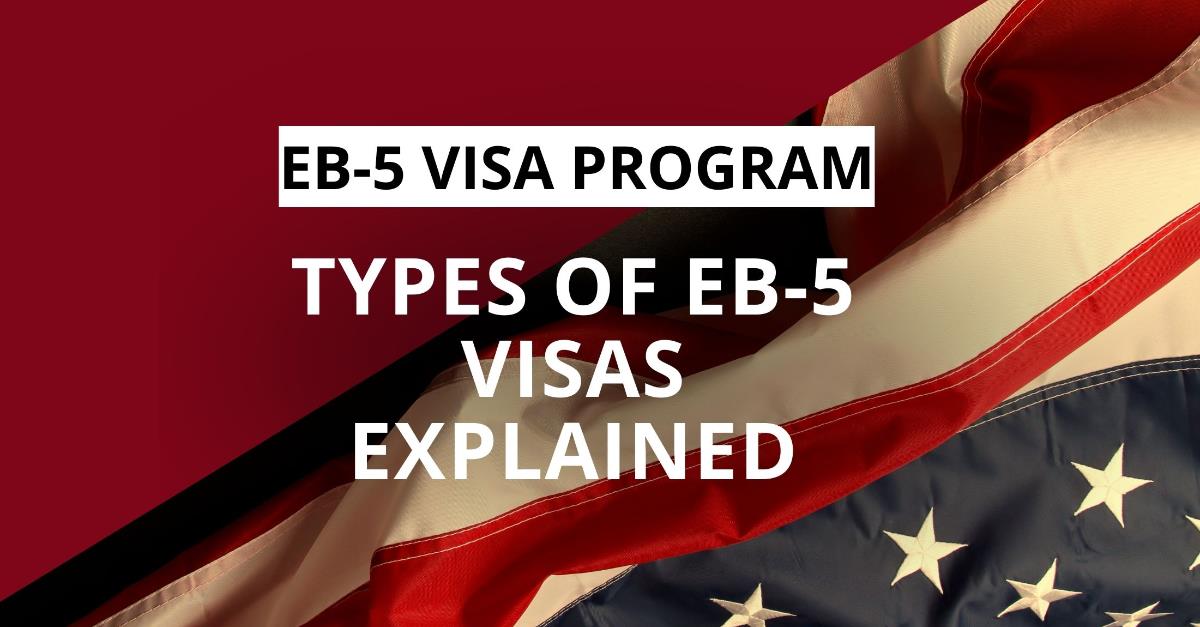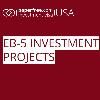PAPERFREE
investment visa
FREE CONSULTATION
Which EB-5 Visa Option is Best for You? Types of EB5 Visa Explained
Understanding the Different Types of EB-5 Visas: Unreserved vs. Reserved Categories Explainedlast updated Friday, April 11, 2025
#EB5 Visa Classification #EB-5 visa
| | by Sidra Jabeen |

QUICK LINKS
AD
Get Access to EB 5 Visa Investment Projects
EB-5 visas are classified into two types: unreserved and reserved visas. However, multiple subcategories exist within the EB-5 visa category. These categories are classified according on investment location and type. Each EB5 Visa category serves a particular purpose, with varying processing times and requirements.
In this post, we'll look at the many types of EB-5 visas and how investors can select the best one for them.
Types of EB-5 Visas
The EB-5 Visa Program is divided into two categories: unreserved visas and reserved visas. Each is suited to a distinct sort of investment opportunity based on project location and nature. Understanding the distinctions between these groups is critical for investors seeking to make educated decisions that are consistent with their immigration and financial objectives.
1, Unreserved EB-5 Visas
Unreserved EB-5 visas refer to investments made in areas that do not qualify as targeted employment area (TEAs). These visas require a higher investment amount, typically $1,050,000, and make up 68% of the annual EB-5 visa allocation. While unreserved visas are available to investors from all countries, applicants from high-demand countries like China and India often face significant backlogs due to high demand, leading to longer processing times compared to reserved visa categories. This option is generally more suitable for investors from countries with lower EB-5 visa demand.
Before the enactment of the EB-5 Reform and Integrity Act of 2022 (RIA), EB-5 visas were classified into four categories based on pre-RIA targeted employment areas and regional centre investments. The four categories were as follows:
- Job creation outside of a targeted location (C5)
- Job generation in a specified location (T5)
- Investor Pilot Program Not in a Targeted Area (R5)
- Investor Pilot Program in a Targeted Area (I5)
According to the US Department of State's Visa Office, these classes are now classified as subgroups of the unreserved visa category. This type of EB5 visa requires a lengthier processing time and a higher investment amount. For example, the wait time in India and China is longer. Visa wait times can last up to a decade for Chinese applicants and more than 55 months for Indian applicants.
2. Reserved EB-5 Visas
Reserved EB-5 visas were introduced under the EB-5 Reform and Integrity Act of 2022, setting aside 32% of the annual EB-5 visa allocation for investments in specific areas that need economic development.
This category includes three subtypes: rural set-aside visas, which account for 20% of the total reserved visas; high-unemployment set-aside visas (10%); and infrastructure set-aside visas (2%).
These reserved visas require a lower investment amount of $800,000, offering investors faster processing times and priority in visa allocation. Investors in rural TEA projects benefit from additional advantages such as USCIS priority processing, making reserved visas an attractive option for those looking to expedite their U.S. residency.
Reserved EB-5 visas are categorized in the following sub-categories:
- Rural Set-Aside Visas (20%)
- High-Unemployment Set-Aside Visas (10%)
- Infrastructure Set-Aside Visas (2%)
Rural Set-Aside Visas (20%)
Rural set-aside visas are allocated for EB-5 investments in rural areas, defined as locations with populations of fewer than 20,000 people that are not part of any metropolitan statistical area (MSA).
These projects are designed to stimulate economic growth and job creation in less developed regions of the U.S. Investors in rural TEA (Targeted Employment Area) projects benefit from several advantages, including priority processing by the United States Citizenship and Immigration Services (USCIS) and faster visa adjudication.
Additionally, the investment threshold is lower at $800,000, making it an attractive option for those seeking expedited processing and a quicker path to a green card.
High-Unemployment Set-Aside Visas (10%)
High-unemployment set-aside visas are reserved for investments in urban areas where the unemployment rate is at least 150% of the national average. These areas, known as urban TEAs, are designated to encourage job creation and economic recovery in economically distressed regions.
Like rural projects, high-unemployment investments also qualify for the lower $800,000 investment requirement. However, investors in this category may not receive the same priority processing benefits as those in rural areas, resulting in longer wait times for visa adjudication.
Despite this, the high unemployment set aside offers a valuable opportunity for investors looking to benefit from a lower entry point.
Infrastructure Set-Aside Visas (2%)
Infrastructure set-aside visas are designated for investments in large-scale public infrastructure projects. This category, introduced by the EB-5 Reform and Integrity Act of 2022, is still under development, with USCIS yet to provide comprehensive guidelines on the types of projects that qualify.
As a result, infrastructure set-aside visas remain less popular among investors. Despite the low 2% allocation, this visa category has the potential to grow in demand once clearer guidelines are established. Investors in this category, like those in rural and high-unemployment areas, can take advantage of the $800,000 investment requirement.
However, the lack of clarity regarding project qualifications has kept interest relatively low so far.
Who is eligible for an Unreserved EB-5 visa?
Unreserved EB-5 visas are available to investors who make an investment of $1,050,000 in projects located outside of targeted employment areas (TEAs), such as rural or high-unemployment areas.
Investors from any country can apply for this visa. Still, it is particularly suited to those from countries with lower demand for EB-5 visas, as high-demand countries like China and India face significant backlogs.
Pre-Reform and Integrity Act (RIA) investors and those whose investments do not qualify for set-aside visas will also fall under the unreserved category.
Who is eligible for a reserved EB-5 visa?
Reserved EB-5 visas are open to investors who file their I-526E petitions after March 15, 2022, and choose projects in rural TEAs, high-unemployment TEAs, or infrastructure development areas.
To be eligible, investors must meet the $800,000 investment threshold and choose projects that have been designated as set-aside EB-5 Visas under the EB-5 Reform and Integrity Act.
This visa type is ideal for applicants from high-demand countries like China and India, as it offers the potential to avoid long backlogs and expedite the process.
How to Choose the RIght EB-5 Visa Category?
Choosing the right EB-5 visa category depends on several factors, including the investor’s financial capacity, immigration goals, nationality, and desired processing speed.
Here are key considerations to guide your decision:
Investment Amount
The investment threshold varies by category. If you can invest $1,050,000, the unreserved visa category may be an option, but if you’re looking for a lower threshold of $800,000, reserved visas (rural, high-unemployment, or infrastructure) offer a more accessible entry point.
Project Location
Reserved EB-5 visas are tied to projects located in targeted employment areas (TEAs), including rural regions, high-unemployment urban areas, or infrastructure development zones. If you’re open to investing in these areas, reserved visas may offer faster processing and additional benefits.
Processing Speed
If you want expedited visa processing, rural TEA projects under the reserved visa category offer priority processing by USCIS. Investors in rural areas often experience faster adjudication times compared to unreserved visa applicants.
Visa Backlogs
For investors from high-demand countries like China and India, choosing a reserved visa can help avoid the significant visa backlogs that exist in the unreserved category. Reserved visa categories offer more availability, reducing the waiting time for a green card.
Project Viability
Conduct thorough due diligence on the project’s financial health and the likelihood of job creation. A solid, well-financed project in a TEA may not only provide immigration benefits but also help protect your investment.
Consulting with an immigration attorney and EB5 Visa Consultants is crucial to understanding the risks, benefits, and long-term impacts of each category on your U.S. residency goals.
When Does an EB5 Visa Prospective Investor Select an EB-5 Visa Type?
An EB5 investor often selects an EB-5 visa type when deciding which project to invest in, as the project's location and categorization define the visa category.
This choice is made early in the process, before submitting the Form I-526E petition. The type of visa—unreserved or reserved—is determined by whether the investment is made in a targeted employment area (TEA), such as a rural or high-unemployment area or in an infrastructure project.
Here are key moments when the choice is made:
- During Project Selection
The choice of an EB-5 visa type hinges on the location of the investment project. If the project qualifies as a rural or high-unemployment TEA or as an infrastructure project, it will fall under the reserved visa category. Investments outside TEAs are classified as unreserved and require a higher investment amount. - Form I-956F Approval
USCIS determines the project’s eligibility for the reserved visa category based on its Form I-956F approval. Investors should review the project’s I-956F notice to confirm its qualification before committing. - Filing Form I-526E
When filing the I-526E petition, the investor selects their visa category based on the location and type of the project. This is the official point at which the visa type is chosen, though it is largely determined by the project chosen.
Careful research and due diligence in selecting the right EB-5 project ensure that investors are matched with the most suitable visa category for their needs.
Frequently Asked Questions
How do I choose the right EB-5 visa category for my investment?
Choosing the right EB-5 visa category depends on factors such as your financial capacity, the location of the investment project, and your desired processing speed. If you can invest $1,050,000 and prefer projects in economically developed areas, an unreserved visa may be suitable. If you’re interested in a lower investment of $800,000 and wish to benefit from faster processing, reserved visas—such as rural or high-unemployment TEA projects—may be a better option. Consult with an immigration attorney to evaluate your options.
What factors should investors consider when selecting an EB-5 visa type?
When selecting an EB-5 visa type, investors should consider the investment amount ($1,050,000 for unreserved, $800,000 for reserved), project location (whether it qualifies as a rural or high-unemployment TEA), expected processing times (rural projects often get priority), and visa backlogs for their country of origin. It’s essential to perform due diligence on the project and consult professionals to ensure it aligns with your financial and immigration goals.
What is the best EB-5 visa option for faster green card processing?
For faster green card processing, investing in a rural Targeted Employment Area (TEA) under the reserved visa category is generally the best option. Rural TEA projects benefit from priority processing by USCIS, meaning investors in these projects typically experience shorter adjudication times compared to other visa types. Additionally, rural TEA projects require a lower investment of $800,000.
When should I decide between reserved and unreserved EB-5 visa categories?
The decision between reserved and unreserved EB-5 visa categories should be made during the project selection phase. The visa category depends on whether the chosen investment project is located in a targeted employment area (TEA), such as rural or high-unemployment areas, or in a non-TEA location. Your visa type will be confirmed when you file Form I-526E, so it’s important to decide based on project location and your investment amount before submitting your petition.
Which EB-5 visa type is ideal for investors from high-demand countries like China and India?
For investors from high-demand countries like China and India, reserved EB-5 visas are the ideal choice. These visas, particularly those associated with rural and high-unemployment TEA projects, offer a way to avoid significant visa backlogs that are common in the unreserved category. By choosing a reserved visa, investors from these countries can benefit from reduced wait times and potentially faster access to U.S. residency.
Free Investment Visa Consultation
Paperfree Investment Visa Social Channel - Instagram
Pages Related to: EB5 Visa Classification, EB-5 visa
- Benefits of commercial hard money loans

- The Lender Checklist: Finding a Solid Real Estate Investment

- Non institutional lenders are taking the center stage

- EB 5 investment projects list USA

- EB5 Investment Visa Guide 2025

- Paperfree Investment Visa EB-5 Program is Your Your Clear Path to Green Card USA

- History of EB-5 Program - An Outlook For Investors

- US Immigration: Big increase in EB–5 visa fees proposed

Popular for the Investment Visa Program
Benefits of the EB-5 Visa Program | Guide
Search within Paperfree.com
